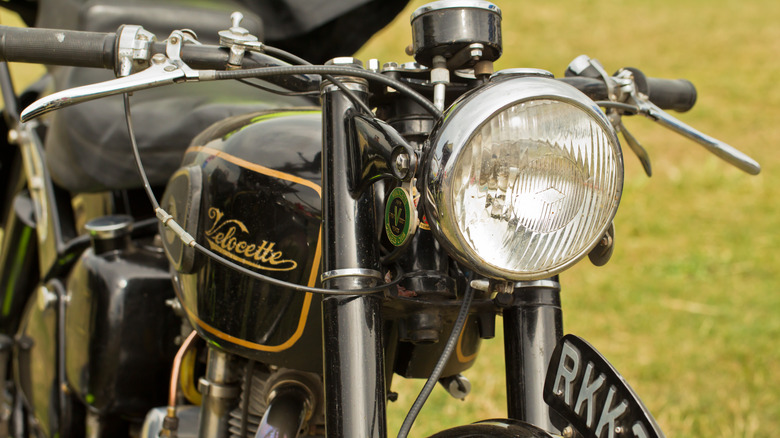
Cbck-christine/Getty Images
Vintage motorcycles have never gone out of style. Most bikers have at least one tried-and-true classic bike in mind that they would like to keep in their garage, and the recent resurgence in the modern retro segment is evidence of this popularity. Vintage brands like Harley-Davidson, Royal Enfield, Triumph, and a newly rekindled BSA and Norton are all currently vying for market share with their chromed classic designs that look as fresh and aspirational today as they have done for the last 50 years or more.
Our list of the most reliable vintage motorcycles focuses only on bikes built before 1975, as this is a rule of thumb for what is considered «vintage.» We have included classic and antique bikes, as the terms are often used interchangeably. The Antique Motorcycle Club of America recognizes bikes over 35 years old as the qualifying age for antiques, and most of our picks far exceed this age.
Most importantly, each bike has a proven record of reliability as a notably robust vintage model, particularly regarding its engine, which is a significant qualifying factor and the foundation of a dependable machine. We explain our methodology in more detail at the end of the article. While this list is by no means exhaustive, the following motorcycles represent some of the most dependable that each of these reputed marques has ever produced.
Honda CB750
Every so often, a bike comes along that significantly impacts not only their respective segments but the industry as a whole. While the Vincent Black Shadow, Kawasaki Z1, and BMW R80 G/S were all game changers in their own way, few bikes left such an indelible mark on motorcycling history as the Honda CB750.
The Honda CB750 is often regarded as the first superbike for its unprecedented performance and trailblazing features. But to understand just how revolutionary it was, you have to look at the global market as a whole, as it was in 1969. The United States was famous for its bulky cruisers, and the UK was responsible for most large-capacity street bikes. Only the Italian MV Agusta had ventured to produce a four-cylinder racing model, but these were well beyond the budget of the average biker.
Honda turned the industry on its head by introducing an affordable two-valve transverse inline four-cylinder model with a 736cc power unit that appealed to speed demons and made practical sense due to its unprecedented reliability. The Honda CB750 still stands out as one of the most accessible and dependable classics, with many still running as they did when they first rolled off the production line.
The acronym «UJM» was soon coined to describe the Universal Japanese Motorcycle, as the three other large firms, Kawasaki, Suzuki, and Yamaha, each produced its own model based on the same features as the CB750. These included four cylinders, disc brakes, a tubular cradle frame, and telescopic forks. All attributes are pretty standard and unremarkable on many modern bikes, but that in itself is a testament to Honda’s progressive thinking that reignited the motorcycle industry and changed biking forever.
Suzuki GS750
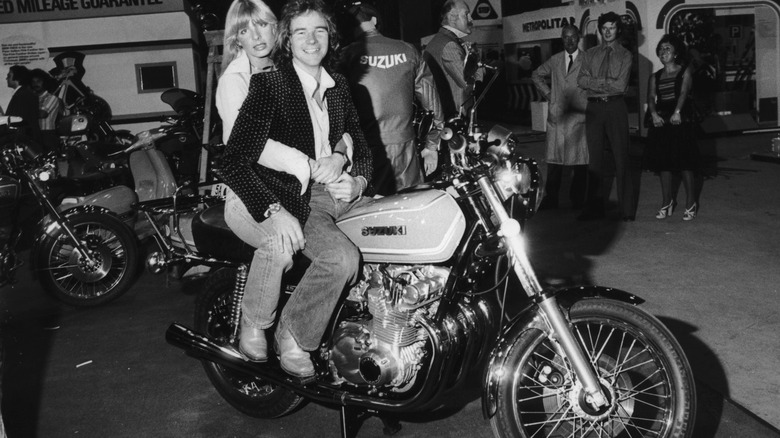
Graham Morris/Getty Images
In 2015, trusted online reviewer Consumer Reports published a survey of 11,000 motorcycles to determine which brand produced the most reliable vehicles. While Yamaha came out on top, Suzuki was a close second. Regarding vintage bikes, the «big four» Japanese manufacturers, Honda, Suzuki, Yamaha, and Kawasaki, were all streets ahead of their Western rivals regarding value, build quality, and reliability.
As one of the previously-mentioned Universal Japanese Motorcycles, Suzuki’s GS750 was its answer to Honda’s CB750. Introduced in 1977, it was dependable and had excellent handling, with a 748cc inline-four engine that produced over 60 horsepower and propelled it to almost 120 miles per hour. This may seem pedestrian to the modern rider, but considering that the quickest production motorcycle of its day, the Laverda Jota, topped out at around 140 miles per hour, it was certainly in the big league of fast production motorcycles, and it had plenty to offer besides speed.
In producing the GS750, Suzuki went all in on a gamble. Having previously been known only for small-capacity two-stroke bikes, and after failing in making a success of its RE-5 rotary engine motorcycle, this four-stroke comparative monster had to succeed to keep the ailing brand afloat. Luckily, it performed well enough to give the classic British and American marques a run for their money and cost considerably less than its rivals at around $2,200 when new. It was also known for its reliability, which, thanks to slick manufacturing methods and intelligent design, is a characteristic of Japanese motorcycles that has endured to this day.
Norton Commando 850
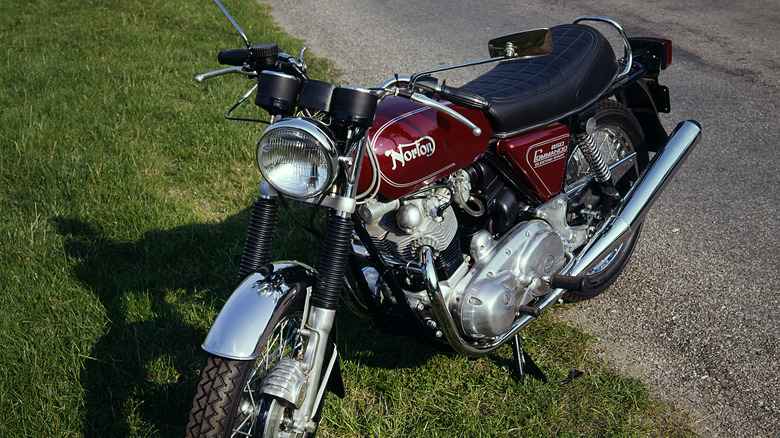
Heritage Images/Getty Images
Norton has a long and distinguished history as one of the great British motorcycle manufacturers of the 20th century. However, things haven’t been smooth sailing for the brand lately, and it went into receivership in 2020. Indian company TVS bought the rights to the Norton name and, in a similar resurrection to the all-but-extinct BSA, has experienced a renaissance with a brand-new Norton Commando 961 for 2023.
Yet, most Norton aficionados fondly remember its past glories and the days when the Norton Commando 850 ruled the roads as the quintessential British parallel twin and a rival to Triumph’s Bonneville, albeit with a little more panache. Released in 1973, the Commando 850 was a bit behind the curve in terms of features, lacking the electric start and drum brakes of its main Japanese rival, the Honda CB 750, although these were added later. While it was more refined than its previous 750cc iteration, it still had torque in spades once you opened up the throttle.
While the Commando 850’s performance couldn’t be described as exciting, its 828cc engine delivered a leisurely, unhurried ride, and it had comfort in spades. Its «Interpol» version became the steed for many law enforcement agencies during its production run as a testament to its proven reliability, primarily attributed to its simplicity, solid engine, and robust four-speed gearbox. Even today, you will see roadworthy Commando 850s on the highway, especially in its native UK, although, as with any vintage bike, regular maintenance and care are essential to avoid disappointment.
Triumph Tiger T100
When we think of classic Triumphs, the Bonneville is usually the first model that comes to mind. This was a trailblazing, reliable, and exciting motorcycle that remains popular to this day. However, it wasn’t the only horse in Triumph’s stable, and the Triumph Tiger T100 is often overlooked as an example of the quality the brand produced in the mid-20th century. This impressive motorcycle’s reliability was proven when travel writer Ted Simon embarked upon a circumnavigation of the world in 1973.
While many of us are familiar with Ewan MacGregor and Charley Boorman’s «Long Way Round» documentary about their motorcycle circumnavigation, this was unheard of in the early 1970s and an even more ambitious prospect due to a lack of infrastructure and the limitations of the motorcycle’s relatively primitive technology. Ted Simon’s book «Jupiter’s Travels» inspired the aforementioned duo to replicate the trip decades later, and it remains ingrained in adventure biking lore.
Under the sponsorship of the UK’s Sunday Times newspaper, Ted traveled over 64,000 miles on his Triumph Tiger 100, a 500cc, twin-cylinder thumper with a four-speed gearbox, rigid frame, and twin exhausts. He completed the circumnavigation in four years, and the bike prevailed. It is now on display at the UK’s Coventry Transport Museum as a shining example of Triumph’s reliability and strength, and the Tiger name lives on in the latest line of adventure bikes from the classic British marque.
BSA A10 Super Rocket
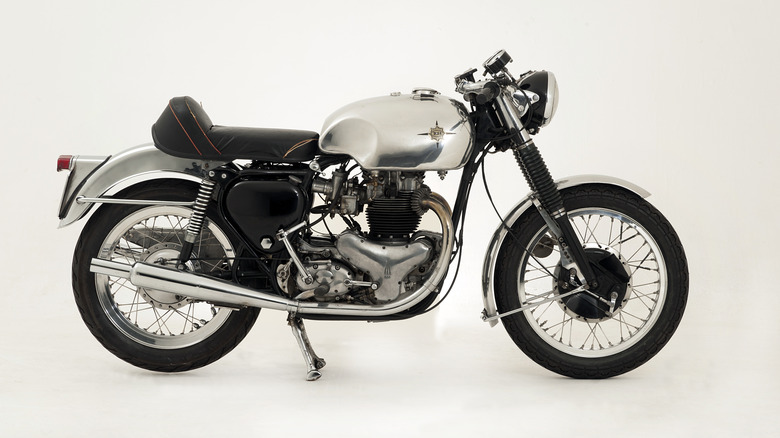
Heritage Images/Getty Images
BSA has been big news in biking circles ever since its re-emergence under the ownership of Indian brand Mahindra and the release of its modern retro Gold Star model. However bright the future of the iconic erstwhile British brand may be, many still look to its historic vehicles as true classics that transcend the decades with their vintage appeal.
While not as famous as the Bantam and Gold Star models and underpowered compared to its comparable rivals at Triumph and Norton, the A10 Super Rocket was a BSA mid-capacity roadster that proved highly reliable, which bolstered its popularity. First introduced in 1957, it was sporty yet refined and perfectly represented the British parallel twins in vogue at the time, with a 646cc engine producing a somewhat reserved 42 horsepower.
As Norton and Triumph competed in the performance stakes, BSA catered to the relaxed motorcyclist with the A10, a rugged and reliable machine that offered all-day comfort in the saddle. At this point, BSA was one of the largest global manufacturers of motorcycles, with legions of fans, and it could afford to pick its own battles.
However, five years later, BSA buckled to the competition and returned to the drawing board. The sprightly A10 was succeeded by the Super Rocket, which boasted several improvements, including modified brakes and transmission. In 1963, production of the Super Rocket ceased, and the company went bankrupt ten years later. It was an era of decline in the British motorcycle industry as a whole, as Japanese bikes ultimately eclipsed them in terms of features, value, and reliability.
Honda CB450 Black Bomber
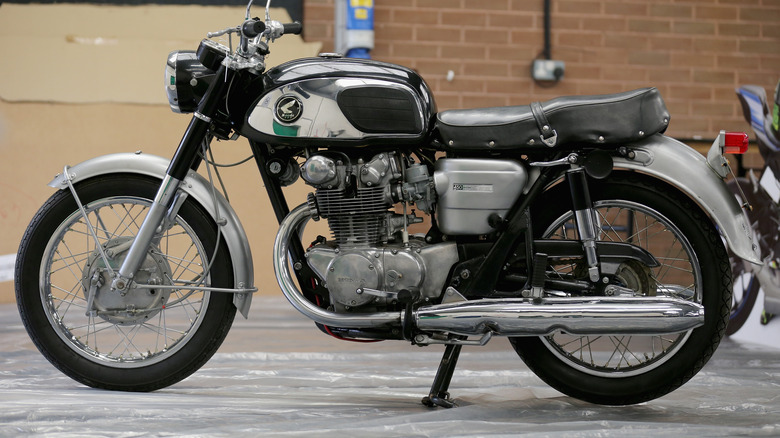
Christopher Furlong/Getty Images
It may be hard to imagine a time before Japanese motorcycles were as popular as homegrown bikes. Still, long before Honda’s CB750 revolutionized affordable large-capacity motorcycles, its CB450 was making waves as one of the first two-wheelers to tap the American market. At the time of its 1965 release, primarily British bikes made their way across the pond. However, the CB450 was distinct from many of its UK counterparts, with modern electrical components and a highly reliable engine, which was to set the standard for Honda’s later models.
As Honda’s first mid-capacity twin-cylinder model, the CB450 was a departure for the «Big Wing» brand, as it previously sold small-capacity off-roaders and racing bikes. Now, it was pitted against the likes of Triumph, Norton, and even the well-established Harley Davidson within this popular segment. Nicknamed the Black Bomber for its singular choice of color scheme, it not only caught the imagination of the American market, but its advertising campaign helped increase motorcycle sales for all brands.
The Honda CB450 wasn’t perfect. It was heavy for its engine size, the rear suspension was underwhelming, and there was vibration through the frame. However, its electric starter (a novelty at the time) worked like a charm, and once up and running, the engine purred like clockwork. Provided you changed the oil every 1,500 miles, it would run and run, and you still see fully functioning Black Bombers in used bike markets 60 years on.
Harley-Davidson XL Sportster
The post-World War II years were a turbulent time for Harley Davidson. Having made it through the conflict due to some sizable military contracts, it was left playing catch-up after soldiers returned from Europe with an appreciation of British bikes, which had started to saturate the import market. As a reaction, it produced the K model, a relatively lightweight twin-cylinder model to compete with those produced by Triumph and Norton. In 1957, the K model evolved into the «XL,» more commonly known as the Sportster.
The Harley-Davidson XL Sportster was considered to be among the most reliable bikes the Milwaukee marque had produced up to that point. A total of 1,983 units were produced, and it sold well, not only as a touring bike but also in motorsports, especially dirt track racing, as the unconventional right-hand-side shifter wouldn’t drag on an anti-clockwise circuit. The bike was characterized by its innovative V-twin engine, which was considerably more compact than the V-twin units H-D had manufactured since the early 20th century.
The XL Sportster’s smaller engine had cast-iron cylinder heads, which proved far more reliable than the «Panhead» aluminum type used on previous models. Its smaller components and lightweight properties facilitated easier customization, and the Sportster saw many upgrades, improvements, and re-releases since its fledgling days as the XL model. To this day, the «Sporty» is one of Harley Davidson’s most beloved models, having returned to the market in 2021 with the Sportster S, a full 64 years after the first XL Sportster was released.
BMW R75/5
The 1970s were a fruitful time for motorcycle development, not only due to the impact of Japanese imports on the industry at large, but they also heralded improvements in engineering, the proliferation of larger, multi-cylinder engines, and more widespread use of electrical components. At the start of the decade, as the UK marques reeled under the pressure of serious competition from the east, BMW had other things in mind. It had just released three new models, the 500cc R50/5, 600cc R60/5, and the 750cc R75/5, which were to become regarded as some of the most bullet-proof bikes of the era.
The «Slash 5» series of BMW bikes with the /5 suffix is considered among the most reliable the Munich marque has ever produced. They were built at the brand-new Spandau, Berlin facility, featuring the «Airhead» boxer twin engine. This type of two-cylinder, horizontally opposed power unit had been used by BMW as far back as 1923 with its R32 model. However, significant improvements meant that this tried and true, reliable design would be the foundation of the R series of motorcycles for decades to come.
As the largest model, the BMW R75/5 was the flagship of the series, and It remains popular among vintage bike collectors worldwide. Its low center of gravity facilitated excellent handling, while its jutting cylinders cooled quickly, and it had ground clearance to spare. Typically, for the brand, BMW opted for a shaft final drive instead of a chain, and the complete unit looks and rides like a modern retro to this day.
Velocette Venom
Fans of the TV show «Peaky Blinders» will be familiar with the English industrial city of Birmingham. For a time, it was the beating heart of motorcycle production in the UK, as the home of respected brands BSA, Ariel, and Velocette, when British bikes were among the most popular worldwide. The latter produced such lauded classics as the Viper, Viceroy, Thruxton, and Venom before experiencing commercial failure in 1971.
Notably, the 500cc Velocette Venom is the only motorcycle to have constantly traveled at 100 miles per hour for a 24-hour duration (via The Vintagent). Even before setting this record, the same bike was tested for 14 hours at well over 100 miles per hour before it was deemed ready for the attempt.
No alterations were made to the engine between testing and setting the record, as a team of eight riders took turns to keep the bike running for 2,400 miles, stopping only to refuel and switch personnel. By the time it was over, the plucky Venom had clocked a total of 3,800 miles at over 100 miles per hour, with an average fuel consumption of 37 miles per gallon. This proved, in no uncertain terms, that the bike was a reliable and well-built model that exemplified the Velocette range. Yet, like many UK motorcycle manufacturers, the brand did not make it through the 20th century.
Honda Super Cub
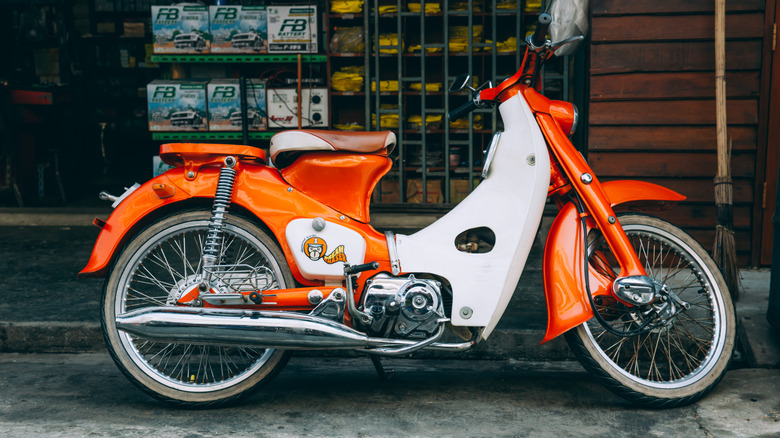
Coffeekai/Getty Images
During the two years I lived in Ho Chi Minh City, Vietnam, I marveled at the millions of small-capacity motorcycles occupying the metropolis. Many of these were Honda Super Cubs or modern rebadged variants, such as the Honda Dream. All harked back to Soichiro Honda’s initial vision to mobilize his nation of Japan during post-World War II austerity. In doing so, he went on to mobilize the entire continent of Asia, and the result has to be seen to be believed.
Having owned and operated a Super Cub for several years, I can attest to the resilience of the world’s biggest-selling motorcycle. With over 100 million units sold since its introduction in 1958, it is comparable to the Fender Stratocaster or the RayBan Wayfarer, a design classic often imitated but has stood the test of time. A large contributor to its success is its reliability, with its surprisingly pokey four-stroke engine, robust semi-automatic gearbox, and lightweight-yet-sturdy construction.
The little Cub’s familiar and friendly aesthetic translated well overseas, and it sold well in the West, thanks in part to a widespread marketing campaign that declared, «You Meet the Nicest People on a Honda.» Yet beyond this initial success, it went on to sell well, year after year, as it proved that it was as dependable as it was affordable.
I paid $800 for mine with over 8,000 miles on the odometer and regrettably sold it four years later for the same price, having ridden an additional 15,000 miles. Those in the know appreciate that a well-looked-after Super Cub will run and run, and it will likely continue to be a best-seller as long as gas-powered motorcycles are still on the road.
How we made our choices
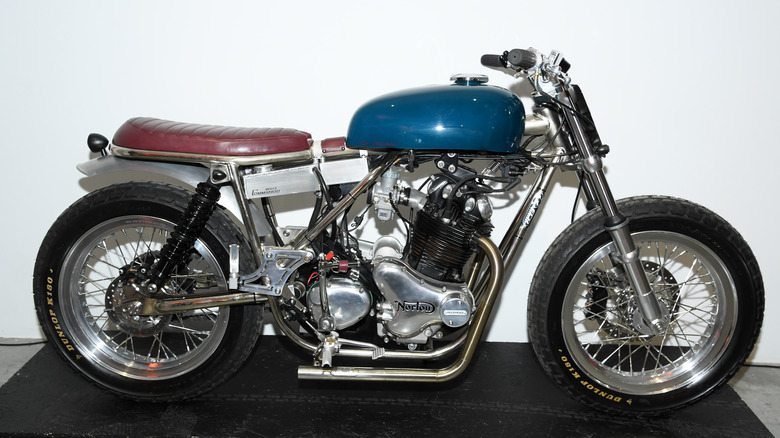
Pascal Le Segretain/Getty Images
Wherever a hands-on experience wasn’t available for reference, we used resources, including Consumer Reports’ 2015 survey and findings in its recent motorcycle reliability report, to identify those brands that produce the most reliable machines. We also considered the results of independent vintage motorcycle tests and reviews published by reputable sources, including Rider magazine, RideApart, Motorcycle News, and Web Bike World.
Mechanical factors were considered, such as robust features, build quality, and engine longevity, which was our chief metric. Where available, we also considered feats of endurance that specific models have performed as proof of that motorcycle’s build quality and reliability.